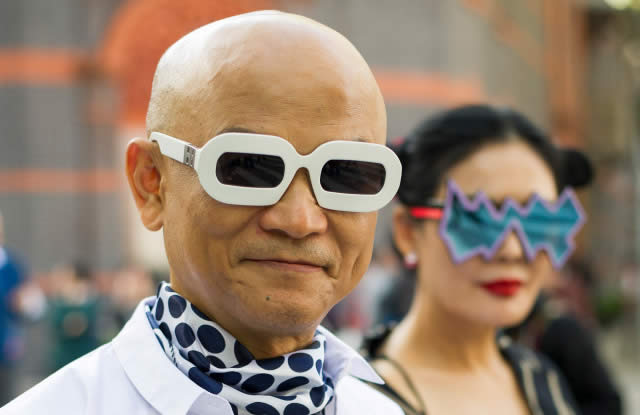Overall, they are looking for low bridge fit and oversized eyewear with dynamic streamlines that balance with the wearer’s delicate features.
LONDON — The idea of a pair of spectacles as a fashion statement is ingrained in many Chinese people’s childhood memories, as a pair of stylish glasses is one of the few things people can use to express their personalities in a nation where a school uniform is mandatory for most students.
If one is wearing a pair of Tom Ford or Gucci glasses, they are then de facto the most fashionable person in school.
This long-lasting association, on top of the fact that more than 50 percent of the Chinese population suffers from myopia, is helping to fuel the country’s robust eyewear market. According to Statista, revenue in the Chinese eyewear market will reach $12.36 billion in 2021, with a compound annual growth rate of 6.31 percent in the next five years.
While the majority are still looking for styles with big logos in traditional department stores or specialty retailers, a growing number of fashion-forward shoppers are seeking one-of-a-kind pieces from fashion boutiques.
Preston Kwong — cofounder of Coterie, a premium eyewear and accessories retail chain in China and Singapore that specializes in designer brands like Balenciaga, Fendi, Tom Ford, Fixxative, ENCL, Ambush and Projekt Produkt — said Chinese consumers’ demand for the category has shifted from “what others think of me” to “whatever I like.”
“Ten years ago, our customers aspired to own a pair of glasses from luxury brands. Today, people are looking to find items from designer brands that reflect their own personalities,” he said, adding that China’s Renoner and Vita Fede from New York are two new brands to watch out for in 2021.
Laura Darmon, head buyer and business development director at the Shanghai-based fashion boutique ENG, observed that a pair of sunglasses is seen more as an accessory than something useful in China, compared to the functionality driven European market.
The store targets the city’s fashion-savvy consumers with a wide range of designer labels, including Alyx, Rokh, Helmut Lang, Kwaidan Editions, Mugler, Ottolinger and We11done, and eyewear pieces from Roberi & Fraud, GmbH, Faux and Justine Clenquet.
Darmon added that eyewear brands like A Better Feeling and Gentle Monster are also gaining good momentum in the market. The latter’s designer collaborations with Xander Zhou, Marine Serre and Sankuanz have been resonating well with the local fashion community.
Yiling Hong, founder of Shanghai’s concept store Canal Street, sells eyewear as simply fashion jewelry. “We want to present sunglasses in a way that it can be more than a summer item. One of our bestselling pieces is this chunky frame style from the Chinese label Soft People Area. What’s so special about this one is that you can change and swap the decorations on the temples, so that your sunglasses can match your outfit of the day.”
When it comes to particular styles, Sofia Makridi, divisional merchandising manager of Pedder Group, which manages fashion boutique Joyce and high-end department store Lane Crawford’s accessories buy, said Chinese customers are looking for a low bridge fit and oversized eyewear with dynamic streamlines that balance the wearer’s delicate Asian features.
For spring 2021, what’s doing well in their stores are oversized frames in various shapes, timeless aviators, retro round frames, and patterned lenses for a distinctive and timeless look from luxury brands such as Dior, Saint Laurent, Gucci, and dedicated eyewear brands like For Art’s Sake, Haze, Henrik Vibskov, Lapima, Linda Farrow and Roberi & Fraud.
Betting on Chinese consumers’ rising demand for premium eyewear with distinctive designs, Pedder Group will introduce Akoni to the market, citing its “fantastic combination of fine materials, incredible design, and cutting-edge production techniques” as a big draw. The Swiss brand was behind last year’s launch of Balmain sunglasses and last month introduced a signature collection.
Makridi noted that, beneath the general trend, regional taste also plays a key part. For example, in Beijing and Shanghai, consumers tend to lean toward designer brands, whereas in Chengdu, there is a more fashion-forward customer and a need to explore and find interesting new brands.
Xiyan Yu, founder of Chengdu’s fashion boutique Hug, agreed that their local customers prefer unique styles with nice details that are under the 2,000 renminbi price mark. The store mixes eyewear pieces from Super, Regards and Myktita with Chinese labels like Uma Wang, Ziggy Chen, and Oude Waag, and international designers such as Stefan Cooke and Hed Mayner in their new futuristic flagship in the city’s Jingronghui Shopping Center.
While Coterie’s Kwong said niche brands with a price range between 1,600 renminbi and 2,000 renminbi, or $250 and $300, like Fixative, Encl, and Dyne are doing better in their stores in first-tier cities like Beijing, Shanghai, Guangzhou, and Shenzhen, luxury brands like Dior, Gucci, and Saint Laurent are performing well in second and third-tier cities like Xi’an, Kunming, and Wuhan.

